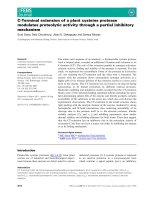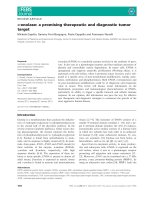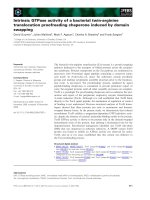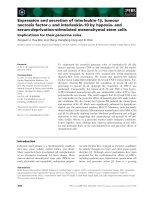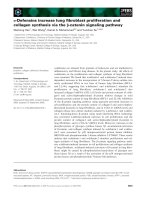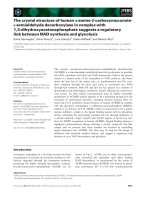Tài liệu Báo cáo khoa học: "A FORMAL REPRESERTATION OF PROPOSITIONS" potx
Bạn đang xem bản rút gọn của tài liệu. Xem và tải ngay bản đầy đủ của tài liệu tại đây (512.43 KB, 8 trang )
A FORMAL REPRESERTATION OF PROPOSITIONS AND T~PORAL ADVERBIALS
Jttrgen Kunze
Zentralinswitut fGr Sprachwissenschaft der
Akademie der Wissenschaften der DDR
Prenzlauer Promenade 149-152
Berlin, DDR-1100
ABSTRACT
The topic of the paper is the intro-
duction of a formalism that permits a
homogeneous representation of definite
temporal adverbials, temporal quanti-
fications (as frequency and duration),
temporal conJ~ctions and tenses, and
of their combinations with propositions.
This unified representation renders it
possible to show how these components
refer to each other and interact in
creati~ temporal meanings. The formal
representation is 0ased on the notions
"phase-set" and "phase-operator", and it
involves an interval logic. Furthermore
logical coz~uections are used, but the
(always troublesome) logical quantifica-
tions may be avoided. The expressions
are rather near to lingaistic struc-
tures, which facilitates the link to
text analysis. Some emprical confir-
mations are outlined.
q. THE GENERAL FRAME
This paper presents some results
that have been obtained in the field
of time and tense-phenomena (K~Luze 1987).
In connection with this some links to
text analysis, knowledge representation
and q~erence mechanisms have been
taken into accoumt.
The formalism presented here differs
from what is under label of temporal
logic on the market (e. g. Prior (1967),
Aqviet/Guenthner (1978). Our main in-
tention is to establish a calculus that
is rather near to linguistic structures
on one side (for text analysis) and to
inference mechanisms on the other
side.
The whole formalism has integrating
features, i. e. the following compo-
nents are represented by the same for-
mal means in a way, that it becomes
easy and effective to refer the differ-
ent components to each other:
- The propositions and their validity
with respect to time;
- Definite temporal adverbials (nex~
wee k , ever~ Tuesda2);
- Definite temporal qu~uti£ications as
frequency (three times) and duration
(three hours), comparislon of fre-
quencies, durations etc.;
- Temporal conj~ctlons;
-
Tenses and their different meanings.
The unified representation renders
it possible to observe how the compo-
nents interact in creating temporal
meanings and relations. Some details
have to be left out here, e. g. the
notion "determined time" and the axio-
matic basis of the calculus.
-
197
-
2. PHASE-SETS AND PROPOSITIONS
A phase
p
is an interval (either un-
bounded or a span or a moment) which a
truth value (denoted by q(p)) is as-
signed to:
q(p) = T : p is considered as an affir-
mative phase.
q(p) • F : p is considered as a denying
phase.
The intervals are subsets of the time
axis U (and never
empty!).
A phase-set P is a pair tP',q3,
where Pa is a set of intervals, and q
(the evalnation function) assigns a
truth value to each pe Pa. P has to ful-
fil the following consistency demand:
(A) For all p,,p"aP" holds:
If p'n p" @ ~, then q(p') • q(P").
A phase-set P is called complete, iff
the union of all phases of P covers U.
Propositions R are replaced by com-
plete phase-sets that express the
"structured" validity of R on the time
axis U. Such a phase-set, denoted by
(R>, has
to
be understood as a possible
temporal perspective of R. There are
propositions that differ from each
other in this perspective only: Por
(I) John sleeps in the dinin~ room~
one has several such perspectives: He
is sleeping there, he sleeps there be-
cause the bedroom is painted (for some
days), he sleeps always there. SO the
phases of (R> are quite different, even
with clear syntactic consequences for
the underlying verb, The local adver-
bial may not be omitted in the second
and third
easel ~
I skip here completely the following
problems:
- A more sophisticated application of
nested phase-sets for the representa-
tion of discontinuous phases in (R>;
- the motivation of phases (e. g. accord-
ing to Vendler (1967)) and their ad-
equacy.
3. PHASE-0PERATORS
A phase-operator is a mapping with
phase-sets as arguments and values.
There are phase-operators with one and
with two arguments. A two-place phase-
operator P-O(PI,P 2) is characterized by
the following properties:
(B) If P = P-O(PI,P2), then P" • P~,
i. e. the set of intervals of the
resulting phase-set is the same as
of the first argument;
(C) For each phase-operator there is a
characteristic condition that says
how q(p) is defined by q1(p) and
P2 for all p £ P~. This condition
implies always that q(p) = F fol-
lows from q1(p) = F.
SO the effect of applying P-O(PI,P 2) is
that some T-phases of PI change their
truth value, new phases are not created.
The characteristic conditions are
based on %wo-place relations between
intervals. Let rel( , ) be such a rela-
tion. Then we define (by means of tel)
q(p) according to the following scheme:
CD)
q(P)
" f
T, if ql(p) =
T and there is
a P2 G P~ with q2(P2) = T
and rel(P2oP);
F otherwise
- 198-
We will use three phase-opera~ors and
define their @v~uation functions in the
following way by (D)s
(E) P = 0CC(P1,P2):
rel(P2,p) is the relation
"P2 and p overlap", i. e. P2nP ~ ~.
(F) P = PER(P1,P2)s
rel(P2,p) is the relation
"P2 contains p", i. e. P2 ~ p"
(G) P = NEX(PI,P2)s
rel(P2,p) is the relation
"P2 and p are not seperated from
each other", i. e. P2uP is an
interval.
As an illustration we consider some
examples. Needless to say~ that their
exact represention requires further
formal equipment we have not introduced
yet. Typical cases for 0CC and PER ares
(2) yesterda~ was bad weather.
Overlapping of (yesterday> and a T-
phase of (bad weather>.
(3) John worked the whole evening.
A T-phase of ( evening> is contained
in a T-phase of (John works>.
(for (evening>, (yesterday> cf. 7.)
There is only a slight difference be-
tween the characteristic conditions for
0CC and NEX: NEX admits additionally
only b~EETS(P2,p) and ~LEETS(p,p2) in the
sense of Allen (1984). Later ! will mo-
tivate that NEX is the appropriate
phase-operator for the conjunction when.
Therefore, sentences of the form
(~) R1, when R 2. (cf. (N), (0))
will be represented by an expression
that contains NEX((R2> , (Rfl>) as core.
The interpretation is thaC nothing hap-
pens between a certain T-phase of (RI>
an~ a certain T-phase of (R2~ (if they
do not overlap).
The next operation we are going to
define is a one-place phase-operator
with indeterminate character. It may be
called "choice" or "singling out" and
will be denoted by xP~, where P1 =
[~,qd] is again an arbitrary
phase-sets
(H) xP - [~,q~,
1 -
P~ = ~ (set of intervals unchanged)
I
T for exactly one p with
ql(p) = T (if there is some
q(p) = T-phase in P1)!
F otherwise
If we need different choices, we write
xP1' YPI' zP2' , using the first sign
as an index in the mathematical sense.
Moreover~we define one-place phase-
operators with parameters:
(I) KAR(PI,n) = [Pm, q]:
P~ = ~ (set of intervals unchanged)
i T, if qfl(p) = T and there are
exactly n T-phases in PI;
q(p) =
F otherwise (for all p g pm
independently of qq(p))
Similarily one defines 0RD(PI,g) for
integers g: ORD(PI,g) assigns the value
T exactly to the g-th T-phase of PI' if
there is one, with certain arrangements
for g (e. g. how to express "t~e last
but second" etc.)
Finally we define the "alternation"
alt(P I) of an arbitrary phase-set P1
=
[l~1,ql]. By alternation new phases may
be create~s alt(P1) contains exactly
those phases which one gets by joining
all phases of P1 that are not seperated
~o - 199 -
from
each other and have the same value
ql(Pl).
So the intervals
of
alt(P I) are
unions of intervals of PI' the q-values
are the common ql-values of their parts
(of. (A)). It is always alt(alt(P1)) =
alt(P1) , and alt(P I) is complete, if
PI is complete. Going from left to
right on the time axis U, one has an
alternating succession of phases in
alt(P1) with respect to the q-values.
alt(P I) is the "maximal levelling" of
the phase-set PI"
4. LOGICAL CONNECTIONS
The negation of a phase-set P1 is de-
fined as follows:
(J) ~PI
=
tP',qG:
P~ = P~ (set of intervals unchanged)
q(p) = neg(ql(p))
Note that (~R> and N(R> may be dif-
ferent because of non-equivalent phase-
perspectives for ~R and R!
For each two-place functor "
u
" (e.
g. "Q" = "v") we aegina PI a P2' if
the sets PI and P2 are equal:
(K) PI m P2 = [Pt'q3:
P'= P;- P~
q(p) = Pu(ql(p),q2(p)) , where F u is
the corresponding truth func-
tion (e. g. vel for " w,,).
Obviously for every phase-operator P-O
the expression P'O(PI'P2) "~ PI repre-
sents both a phase-set and a clear "tau-
tology" - in other words - a phase-set
that is "always true", if PI is complete.
Therefore, alt(P-0(PI,P2)-~P1 ) = U °
(where U ° is the phase-set that contains
the time axis U as the only interval
with the q-value T) reflects the double
nature of the aforesaid implication.
5. TRUTH CONDITIONS
The last considerations lead imme-
deately to the following definitions.
The whole formalism requires two types
of truth conditions, namely
(L) alt(P) = U °
(M) alt(P) # ~U °
•
They have different status: (L) is
used, if the phase-set P is considered
as a temporal representation of some-
thing that is valid, independently of
time. (M) is applied~if P is considered
as something that represents a certain
"time" (expressed by the phases of P).
Because of the second possibility, alt
appears not only in truth conditions,
but it may constitute arguments in
phase-operators etc., too. This will be
shown in the examples below.
Obviously one has for arbitrary
phase-sets P = [P',q~,
alt(P) = U ° iff Vt~U~pGP~
Cq(p)
= T • tap)
altCP) ~ ~U° iff ~t GU 3p~P~
CqCp)
=
Ta tGp)
6. SOME CO tgIRNT ON THE PORMALISM
By regarding the time axis U as a
basic notion one has to take the
trouble to consider the topology of U,
and gets difficulties with closed and
- 200 -
and open sets, environments etc This
may be avoided by taking an axiomatic
viewpoint: For all operations, relations
etc. one formulates the essential prop-
erties needed and uses them without di-
rect connection to the time axis. In
this way U becomes a part of a model
of the whole formalism. This is inde-
pendent of the fact, that in definitions
and explanations U may appear for mak-
ing clear what is meant.
7 • TEMPORAL ADVERBI ALS
In section 2. we have outlined, how
propositions R are substituted by phase-
sets (R>. The same has to be done for
temporal adverbials. First we consider
definite adverbials: (tuesday> is a
phase-set P, where P~ is the set of all
days (as spans p covering together the
whole time axis U), and exactly the
Tuesdays have the value q(p) = T. For
(day>~he set pm is the same, but it
is q(p) = T for all p G Pm. (evening>
has as intervals suitable subintervals
of the days with q(p) = T, whereas the
remaining parts of the days form phases
with q(p) =
F
in (evening> . Analo-
gously ( e~> contains all years as
spans p with q(p) = T, whereas (1986>
has the same spans, but exactly one
with q(p) = T.
Now we combine temporal adverbials
with propositions. An e~ct representa-
tion would require that we list all
possible structures of phrases, clauses
etc. that express a certain combination.
We use instead of this "standard para-
phrases" as "a~ least on Tuesdays R". If
R is a certain proposition, e. g.
R = John works in the library , then
this paraphrase stands (as a remedy) for
(5) John works, worked, in the
library every Tuesday.
On every Tuesda~ John
On Tuesda~ of ever~ week John
A~ least on Tuesdays John
Examples with truth condltionas
(6) (the days, when R>
= occ(<day>, (R>)
~t( ) , ~u ° (cf. (~) - (E))
(7) (the Tuesdays in 1986 , when R >
= 0CC(OCC((tuesday>,(R>), (1986>)
~t( ) ~ ~u
°
(8) (at least on Tuesdays E >
= (tuesd%7> -~ OCC((day~, (R>)
alt( ) =
u °
(cf. (~))
(9) (at most on Tuesd%ys R>
= OCt(( daft, (R>) -~ < tuesday >
alt( ) = U °
(10) (in 1986 at least on Tuesdays R>
= ( 1986 >
-~
PER(( year>,
alt((tuesd> -~ OCC((day>, < R>)))
alt( ) = u ° (cf. (F))
(1986 is a year, throughout which
it is always true, tha~ every
Tuesda~ is a day, when R occurs.)
The second argument of PER is a phase-
set defined by an air-operation. This
phase-set has as T-phases exactly those
maximal periods during which (8) holds.
,
PER((~ear~, ) selects the years that
are covered by such a period, and the
whole expression says that 1986 is such
a year (and nothing about other years).
The time of speech L is formally rep-
resented by a phase-set L ° with three
phases, namely L itself with q(L) = T,
and the two remaining infinite inter-
vals with the q-value F. Then one may
define (today> = 0CC((day~,L°). By
- 201 -
using the phase-operator ORD (cf. (I))
one introduces (yesterday) etc., and
similarily (this year> etc
(11) (in this year three times R
=
(R)"~KAR(OCO((R), (this
year}),3)
alt( )
= U °
(12) (the three times R in this ye _ar)
=
KAR(OCC((R), (~his
year))
,3)
sit( )
+
~U °
In (11) a yes-no-decision is expressed
(there are three T-phases of (R)in this
year), but in (12) a "time" is defined,
namely the three T-phases of (R> in this
year. Therefore~the truth conditions
are different. The expression in (12)
may appear as an argument in other ex-
pressions again.
Now we apply the operation "choice":
(13) (at most on Tuesdays three times R)
=
V
OCC(x(da~),
KAR(OCC((R), x(day~),3))
-~<tuesda~)
alt( ) = U °
OCC((R),x(day>) determines the T-phases
of (R) on a single day, KAR( ,3) keeps
them iff there are exactly three (other-
wise they become F-phases, cf. (I)),
OCC(x(day}, ) assigns to the single
day the value Tiff the T-phases of (R)
on this day have been preserved. There-
fore, ~OCC( , ) is a T-F-distribu-
tion over all days if x runs over all
days, and the whole expression says
that all T-days are Tuesdays.
(q~)
(15)
(exactl~ on Mondays and Fridays R)
coo(( day>, (at)
((monde~) v (~>)
alt( )
=
u °
(of. (8), (9))
(never on Tuesdays
R>
OOO(( day), (R)) -~ ~ (tuesday)
alt( )
= u °
(cz. (9))
These examples demonstrate the applica-
tion of logical functors.
As
one oan see, the e~pressions ren-
der
it possible to formulate even rath-
er complex temporal relations in a com-
prehensible manner without much redun-
dancy, the necessary arguments appear
only once (or twice for certain quanti-
fications as e. g. (tuesday) and (da~
in (8)). In order to handle durations,
one needs another phase-operator EXT
that is quite similar to KAR and ORD.
The argument R stands either for "bare"
propositions (without any temporal com-
ponent) or for propositions with some
temporal components. In the latter case
the corresponding expression has to be
substituted for (R):
(q6) Ever~ Tuesda~ John watches tele-
vision in the evening.
Take (R) = (in the evenin~ R')
with R' = John watches television.
Then one can represent (R) by
(R) = OCC( (R'}, (evening))
with alt( ) ~ ~U ° (John's t.v
phases in evenings) and apply (8):
( tuesda~ ) -~
OCC(( day},0CC(( R' ), (evening~) )
alt( ) = U O
Similarily one obtains (qO) from (8).
The truth condition in (8) causes that
alt( ) occurs as argument in (qO).
The sign "=" in the examples means that
the left side is defined by the right
side, the left side is stripped of one
(or more) temporal components. In this
sense (6), (8) and (9) are rules, (7)
and (I0) include two rules in each case.
The full and exact form of such rules
requires more than the standard para-
phrases,
namely corresponding (syntac-
tic) str~ctures
on
their left side.
- 202 -
8. TENSES
Till now nothing has been said about
tenses. It is indeed possible to repre-
sent tenses in the formalism that we
have outlined. But it is impossible to
introduce "universal" rules for tenses.
Even between closely related languages
like English and German there are essen-
tial differences. So it does not make
sense to explain here the details for
the German tenses (of. Kunze 1987).
The main points in describing tenses
are these: At first one needs a dis-
tinction between "tense meanings" and
"tense forms" (e. g. a Present-Perfect-
form may be used as Future Perfect).
After that one has to introduce special
conditions for special tense meanings
(e. g. for perfect tenses in German and
English, for the aorist in other lan-
guages). Further a characterization of
tense meanings by a scheme like Reichen-
bach's is necessary, including the in-
troduction of the time of speech L °.
On this basis rules for tense-assign-
ment may be formulated expressing whioh
tenses (= meanings) a phase xP or a
phase-set P can be assigned to. From
the formal point of view tenses then
look like very general adverbials, and
it is rather easy to explain how tenses
and adverbials fit together. Tense-
assignments create new expressions in
addition to those used above.
It
is im-
portant that the position of the phases
of (R> does not depend on the tense R
is used with: The tense selects some of
these phases by phase-operators. So
alt(NEX(xP,L°)) • ~U ° is the basic con-
dition for the actual Present (of. (G)).
9. TEMPORAL CONJUNCTIONS
For some temporal conjunctions there
are two basic variants, the "particular"
usage and the "iterative" usage. We il-
lustrate this phenomenon for when:
(N) whenl (particular usage of when):
WHENI(RI,R2): (for "RI, when R2")
alt(NEX((~2>,(~1~ )) *
~u °.
(17) When John went to the librar~
he found 10 ~. (Once t when )
In (17) there is a reference to a single
T-phase of (RI> and a single T-phase of
(R2). One can show that the truth con-
dition for when I is equivalent to
3x SyCaltCNEXCx(R2),YCRI>)) * ~U °) ,
but this form is avoidable (cf. (H)
and the end of 5.).
(0) when2(iterative usage of when):
WHEN2RI,R2): (for "RI, when R2")
(18) When John went to the library.
he took the bus. (Whenever )
In (18) something is said about all
T-phases of (R2~ , namely
Vx 3y(alt(NEX(x(R2~ ,y(R~ ) * NuO) ,
which is equivalent to the truth condi-
tion for when 2.
Conjunctions like while, as lon~ as
etc. are represented in a similar way
with the phase-operator PER (cf. (F)).
For the conjunctions after, before,
since and till one needs in addition an
ANTE- and a POST-operator, which are
tense-dependent (the main difference
is caused by imperfective vs. perfec-
tive) and modify the arguments of the
phase-operators. Some of the conjunc-
tions have both basic variants, whereas
since admits no iterative usage.
- 203 -
The meaning of since is expressed by
(P) since: (only particular usage)
SINCE(Rfl,R2): (for "Rfl, since R2")
alt(P~(PosT((~2)), (RI)~ ~ ~u °,
and the truth condition for afterq is
(Q) afterq (particular usage of after)s
AFTERI(Rq,R2): (for "Rq, after R2")
alt(PER((RI~ ,POST((R2)))) , ~U °
It turns out that an analysis of tem-
poral conjunctions based only on the
Reichenbach scheme causes some difficul-
ties. It works very well for when and
while (cf. Hornstein 1977) and the Ger-
man equivalents (als/wenn, w~hrend and
solam~e), but for the remaining cases
ANTE- and POST-operations seem to be
inivitable.
qO . AN F~iPIRI CAL CONFIP~IATION
By combining the rules for te~se-as-
sig~ment and the truth conditions for
the temporal conjunctions (in German
there are seven basic types) and by al-
lowing for some res~rictiomsfor their
use (e. g. als only for Past, seit not
for Future) one gets for each conjunc-
tion a prediction about the possible
combinations of tenses in the matrix
and the temporal clause.
Gelhaus (q97@) has published statis-
tical data about the distributions
of
tenses in the matrix and the temporal
clause for German. From the huge L!MAS-
corpus the took all instances of the use
of temporal conjunctions. From my cal-
culus one cannot obtain statistics,
of course, it decides only on "correct-
hess". The comparlsion proved that
there is an almost complete coincidence.
The combinations for als/wenn cannot be
derived, if one takes OOC instead of NEX
in (N) and (O). The same seems to be the
case for when. The restrictions for the
propositions R I and R 2 (e. g. [+FINIT]),
given by Wunderlich (1970), can be de-
duced from the truth conditions (details
about both questions in (Kunze (1987)).
REFERENCES
Allen, James P 1984 Towards a General
Theory of Action and Time. Artificial
Intelli~ence 23 (1984): 123-154.
Aqvist, Lennart, Guenthner, Franz.1978
Fundamentals of a Theory of Verb As-
pect and Events within the setting of
an Improved Tense Logic. In: Studies
in Formal Semantics (North-Holland
Linguistic Series 35), North-Holland:
167-199.
Gelhaus, Hermann. 1974 Untersuchungen zur
consecutio temporum im Deutschen. In:
Studien zum Tempus~ebrauch im Deut-
sche_.__~n (¥orechungsberichte des Insti-
ruts ~
deutsche Sprache, Nr. 15).
Verlag Gunter Narr, TUbingen: 1-127.
Hornstein, Norbert.1977 Towards a Theory
of Tense. Linguistic Inuuir~ ~ (3):
521-557.
Kunze, JUrgen.1987 Phasen, Zeitrelatio-
nen und zeitbezogene Inferenzen. In:
Kunze,J. Ed., Problems der Selektion
un~ Semantik (Studia Grammatica 28)
Akademie-Verlag, Berlin: 8-154.
Prior, Arthur N.1967 Past, Present,
Future. Clarendon Press, Oxford, U.K.
Vendler, Zeno.1967 Linguistics in Phi-
losop~y. Cornell University Press,
Ithaca, New York.
Wunderlich, Dieter.1970 TemDus und Zeit-
referenz im Deutschen. Linguistische
Reihe 5, MtLuchen.
204
